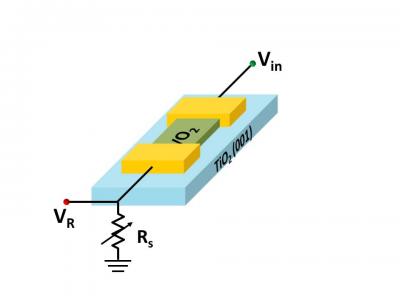Strongly interacting electrons in wacky oxide synchronize to work like the brain

This is a cartoon of an oscillating switch, the basis of a new type of low-power analog computing. Credit: Credit: Nikhil Shukla, Penn State
Vanadium dioxide is called a “wacky oxide” because it transitions from a conducting metal to an insulating semiconductor and vice versa with the addition of a small amount of heat or electrical current. A device created by electrical engineers at Penn State uses a thin film of vanadium oxide on a titanium dioxide substrate to create an oscillating switch.
Using a standard electrical engineering trick, Nikhil Shukla, graduate student in electrical engineering, added a series resistor to the oxide device to stabilize oscillations over billions of cycles. When Shukla added a second similar oscillating system, he discovered that, over time, the two devices began to oscillate in unison. This coupled system could provide the basis for non-Boolean computing. Shukla worked with Suman Datta, professor of electrical engineering, and co-advisor Roman Engel-Herbert, assistant professor of materials science and engineering, Penn State. They reported their results today (May 14) in Scientific Reports.
“It's called a small-world network,” explained Shukla. “You see it in lots of biological systems, such as certain species of fireflies. The males will flash randomly, but then for some unknown reason the flashes synchronize over time.”
The brain is also a small-world network of closely clustered nodes that evolved for more efficient information processing.
“Biological synchronization is everywhere,” added Datta. “We wanted to use it for a different kind of computing called associative processing, which is an analog rather than digital way to compute.”
An array of oscillators can store patterns — for instance, the color of someone's hair, their height and skin texture. If a second area of oscillators has the same pattern, they will begin to synchronize, and the degree of match can be read out.
“They are doing this sort of thing already digitally, but it consumes tons of energy and lots of transistors,” Datta said.
Datta is collaborating with Vijay Narayanan, professor of computer science and engineering, Penn State, in exploring the use of these coupled oscillations to solve visual recognition problems more efficiently than existing embedded vision processors.
Shukla and Datta called on the expertise of Cornell University materials scientist Darrell Schlom to make the vanadium dioxide thin film, which has extremely high quality similar to single crystal silicon. Arijit Raychowdhury, computer engineer, and Abhinav Parihar graduate student, both of Georgia Tech, mathematically simulated the nonlinear dynamics of coupled phase transitions in the vanadium dioxide devices. Parihar created a short video simulation of the transitions, which occur at a rate close to a million times per second, to show the way the oscillations synchronize. Venkatraman Gopalan, professor of materials science and engineering, Penn State, used the Advanced Photon Source at Argonne National Laboratory to visually characterize the structural changes occurring in the oxide thin film in the midst of the oscillations.
Datta believes it will take seven to 10 years to scale up from their current network of two-three coupled oscillators to the 100 million or so closely packed oscillators required to make a neuromorphic computer chip. One of the benefits of the novel device is that it will use only about one percent of the energy of digital computing, allowing for new ways to design computers. Much work remains to determine if vanadium dioxide can be integrated into current silicon wafer technology.
“It's a fundamental building block for a different computing paradigm that is analog rather than digital,” said Shukla.
Also contributing to this work are Eugene Freeman and Greg Stone, all of Penn State; Haidan Wen and Zhonghou Cai, Argonne National Laboratory; and Hanjong Paik, Cornell University.
The Office of Naval Research primarily supported this work. The National Science Foundation's Expeditions in Computing Award also supported this work.
Media Contact
More Information:
http://www.psu.eduAll latest news from the category: Power and Electrical Engineering
This topic covers issues related to energy generation, conversion, transportation and consumption and how the industry is addressing the challenge of energy efficiency in general.
innovations-report provides in-depth and informative reports and articles on subjects ranging from wind energy, fuel cell technology, solar energy, geothermal energy, petroleum, gas, nuclear engineering, alternative energy and energy efficiency to fusion, hydrogen and superconductor technologies.
Newest articles

Bringing bio-inspired robots to life
Nebraska researcher Eric Markvicka gets NSF CAREER Award to pursue manufacture of novel materials for soft robotics and stretchable electronics. Engineers are increasingly eager to develop robots that mimic the…

Bella moths use poison to attract mates
Scientists are closer to finding out how. Pyrrolizidine alkaloids are as bitter and toxic as they are hard to pronounce. They’re produced by several different types of plants and are…

AI tool creates ‘synthetic’ images of cells
…for enhanced microscopy analysis. Observing individual cells through microscopes can reveal a range of important cell biological phenomena that frequently play a role in human diseases, but the process of…





















